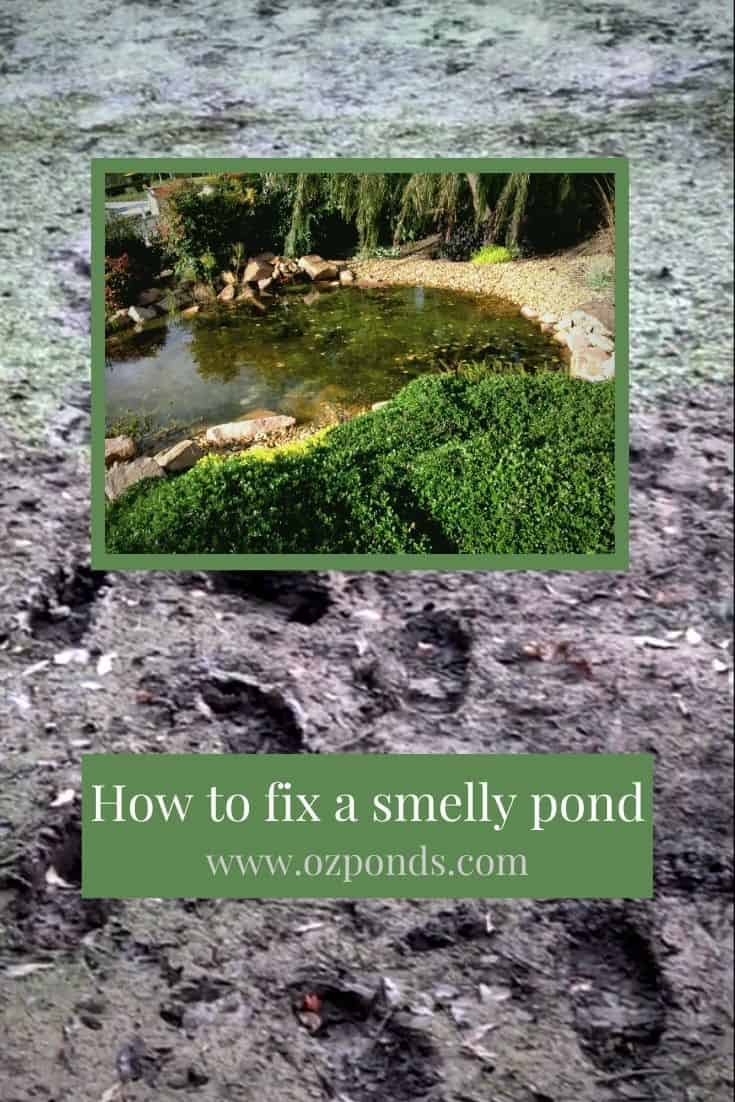Generally the cause of a bad smelling pond is a lack of oxygen and too much organic material at the bottom of the pond.
When organic materials such as leaves sink to the bottom of your pond they begin decomposing.
This decomposition leads to the release of gasses.
When there is little to no oxygen in the pond anerobic bacteria thrive.
A pond with low oxygen levels and plenty of anaerobic bacteria will have a nasty smell.
How to fix a smelly pond
Add oxygen
The first thing we need to do is add oxygen.
Oxygen in the water allows aerobic bacteria’s to thrive.
Aerobic bacteria work much faster than anaerobic bacteria. This means they can break down organic materials much faster.
Bacteria is incredibly important to the function of a pond.
To learn more about the role bacteria plays in a pond ecosystem read my article on “a quick guide to the nitrogen cycle“.
The easiest way to provide the water with plenty of oxygen is adding an aerator (there are plenty available on amazon).
It’s quick and easy to retrofit an existing pond with aerators.
Remove as much organic material as possible
The next step is removing as much organic material as possible.
As the organics break down they settle on the bottom of the pond. If the bacteria cannot break them down fast enough a layer of sludge will develop.
A little sludge is ok.
But if the sludge layer becomes too thick oxygen will become depleted.
As we know if the oxygen levels are too low we are only left with anaerobic bacterias. They work much slower and will omit a foul odour.
If the pond is small remove it by hand. You’ll be surprised how much organic material you can scoop up with just a fish net and a bucket.
If the pond is larger you might like to use a pond vac. I like the oase models.

Some people prefer to give their pond a big cleanup every spring to remove the build up of sludge from the previous season.
Every pond is different but removing organic material once a year is a good habit.
If you don’t wanna get your hands dirty you could use a sludge eating enzyme. These are fish safe.
Also consider the old saying “prevention is better than cure.”
Adding filters that can remove organics before they settle will help reduce the amount of maintenance.
I like to use skimmers or intake bays. You can read my article on skimmers here.
If lower maintenance is something you desire then adding a bog or wetland filter is also a topic you should learn more on.
I love bogs and wetlands as filters and have a helpful article on how to build your own. “diy pond filter“.
Add bacteria
After the pond has been cleaned out add some beneficial bacteria back into the pond.
Adding bacteria to your pond should be something you do regularly.
Bacteria break down organic materials into smaller particles that can be pumped into the filters where they are more easily removed.
But they also keep the water clear and safe for your fishy friends.
Nitrifying bacteria do occur naturally and will colonise a pond wether you add them or not, but they get lazy.
Adding in fresh batches often ensures that they are functioning at optimal potential.
Bacteria need rough surfaces to live on. For this reason i add rocks and gravel to my ponds.
I like to create an ecosystem.
Add plants
An integral part of the ecosystem is plants.
Plants will help remove nutrients from the water.
The fish and decaying materials add nutrients to the water. Too many nutrients and you’ll end up with an algae problem.
Algae reproduces fast. As it dies it adds to the amount of organic material that needs to be broken down by the bacteria.
Providing plenty of plants in the pond will help consume some of these nutrients. That will stop algae from dominating.
By creating lots of variation and a diverse ecosystem it makes it very hard for one species to dominate.
Why you need to fix a smelly pond
Apart from the obvious offensive odour.
A smelly pond needs fixing because it points to a pond that isn’t functioning perfectly.
The lack of oxygen is bad for aquatic life and if not fixed can lead to fish fatalities.
Smelly ponds often have far too many nutrients.
As all the organic material decomposes in the pond it also releases nutrients directly into the water.
Ponds with high nutrients are susceptible to high concentrations of algae. The algae grows to consume the nutrients.
Algae is quick growing and short lived so as it dies it sinks to the bottom and adds more organic material, thus more nutrients to the pond.
This is a horrible merry-go-round as the cycle just keeps repeating.
High concentrations of algae or other water weeds that dominate the pond surface can eventually starve the pond of oxygen, again making it not safe for aquatic life.
Also algae or weed riddled ponds just look awful!
Thanks for reading and i hope this has been helpful.
If you want to contact me for any reason visit the get in touch page.
Subscribe
Sometimes i receive special offers and discounts from pond product suppliers and distributors. I love passing these savings onto the readers.
If you would like to receive these offers direct to your inbox, sign up using the button below.

